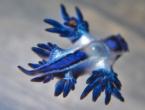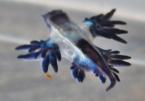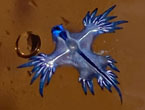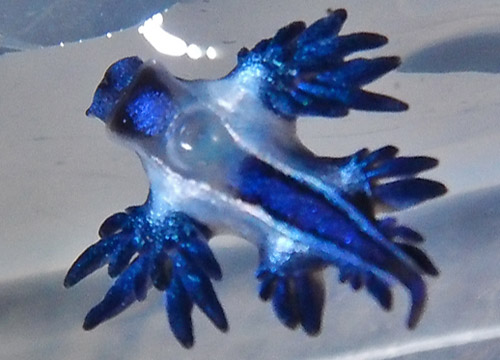| Home |
| Acknowledgments |
| Conventions |
| Glossary |
| Maps |
| References |
| Links |
| Articles |
| Thumbnails |
| Species
list |
| Family |
| Next
species |
Additional Photos

rear

side

large

Glaucus mcfarlanei Churchill, Á. Valdés & Ó Foighil, 2014

| Maximum size: about 7 mm. Identification: This broad, flattened aeolid is bright blue on the ventral surface (facing upward in the photo) and lighter blue on the dorsal surface. Its cerata extend laterally from three distinct pairs of lobes. In contrast to Glaucus atlanticus, the cerata are stacked in multiple, irregular rows on each lobe with the uppermost ones being shorter. Natural history: Glaucus mcfarlanei is a rarely seen pelagic species. They are holoplanktonic, spending their entire lives drifting with the foot oriented toward the surface. They float partially by means of an air bubble that they have swallowed and stored in their gastric cavity (visible in above photo) and are able to move toward prey or mates by using their cerata to make slow swimming movements. They eat a variety of drifting prey including the siphonophore Physalia utriculus (Portuguese man-o-war). Like many other aeolids, they store the nematocysts from their prey in the tips of their cerata for protection against predators. Unlike in most aeolids, the sting can be felt by humans. The dark ventral coloration (which faces the sky) may help in concealing them from birds while the light dorsal coloration (facing down) may help in concealing them from fish. Like Glaucus atlanticus, it lays floating, linear egg strings. Distribution: Big Island, Maui, Oahu and Niihau: north Pacific. Taxonomic notes: This species is sometimes listed as Glaucilla mcfarlanei. It was first reported in Hawaii from Kona, Big Island in Churchill, et. al. (2014). (Note 1) Photo: Cassidy Grattan: about 5 mm: Lehua Islet, Niihau; June 1, 2015. Observations and comments: Note 1: Churchill, et. al., (2014) found Glaucus marginatus to be a cryptic species complex with three members in the north Pacific: G. marginatus, G. thompsoni and G. mcfarlanei. Since the three species are superficially identical, it's possible that more than one may be present in Hawaii although G. mcfarlanei was described from Hawaiian material. |
| Thumbnails |
Species
list |
Family | Next species | Top |